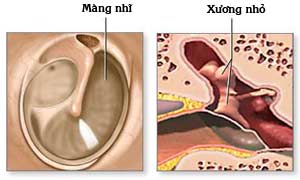The eardrum is located at the end of the external ear canal, separating the middle ear from the outer ear. The taut part of the eardrum consists of an epithelial layer, fibrous tissue, and mucosa. There are three primary reasons that often lead to a perforated eardrum: sharp objects piercing the ear (direct trauma), excessive pressure exerted on the eardrum (indirect trauma), and infections from the nasal cavity and throat causing fluid or pus accumulation in the middle ear, resulting in a rupture from the inside out (otitis media).
 |
(Image: pennhealth) |
When the eardrum is perforated, it can cause sharp pain in the ear, bleeding, tinnitus, dizziness, and hearing loss. In cases of perforation due to acute otitis media, symptoms often include fever, warmth, pain in the ear, and tinnitus. If the perforation becomes infected and is not treated promptly, it can lead to mastoiditis, and even more severe complications such as meningitis, brain abscess, facial paralysis, and sinus thrombosis.
In terms of treatment, doctors will need to repair the eardrum. This surgery can be performed at Ear, Nose, and Throat (ENT) centers or departments in hospitals. To prevent eardrum perforation, it is advisable to be cautious when inserting sharp objects into the ear. If one suffers from nasal or throat diseases, active treatment is necessary to avoid otitis media with pus that may lead to eardrum perforation.
Dr. Lien Huong




















































